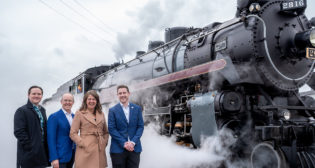
Short Line Railroad of the Year
Written by AdministratorFor Texas short line, “Customer is king”. In 12 years, an upstart short line powerhouse has increased freight traffic 20-fold. In Texas, “think big” is a maxim, even for the smaller things such as short line railroads. Blacklands Railroad, Railway Age’s 2011 Short Line Railroad of the Year, certainly qualifies.
But for President Wayne Defebaugh, the corollary is: Think “customer.”
“Service is our biggest asset, and our slogan is ‘24/7 service on demand,’” Defebaugh says. “That means if a customer has a need that we can help with, we will do it. Our trainmaster will contact the customers on a daily basis and all of our customers can contact the trainmaster so everyone knows who’s doing what and when.
“‘Service on demand’ means we stay in constant contact with all of our customers via our office, cell phones, or Internet, etc.” he says. “That way, when either the customer or the railroad has issues or delays, everyone knows. Those customers who want to know where our crews are and at what time of day they will get a switch can find out by calling our office.”
Based in the northeast Texas city of Sulphur Springs, Blacklands Railroad provides freight rail service on the former St. Louis Southwestern (Cotton Belt) railroad between Mt. Pleasant and Greenville, Tex. The majority of this trackage is owned by NETEX, the Northeast Texas Rural Rail District; some trackage is leased from the Union Pacific. Blacklands Railroad recently added 14 additional miles of trackage with the opening of the Henderson-Overton Branch Railroad, operating this portion for the Rusk County (Tex.) Rural Rail District, roughly east-southeast of Dallas.
Twelve years of growth
The short line, founded in 1999, has interchanges with Union Pacific at Mt. Pleasant, with Kansas City Southern at Sulphur Springs and at Greenville, Tex., and with RailAmerica’s Dallas Garland & Northeastern Railroad, also in Greenville. At one time, the route was the main line connection of the Cotton Belt Railroad from Dallas to Texarkana, Tex. “The original short line segment in 1999 was approximately 25 miles long, served three communities and moved a total of 250 railcars a year,” Defebaugh recalls.
Blacklands Railroad now stretches almost 74 miles from Mt. Pleasant, Tex., to Greenville, Tex., serves six communities, and moves more than 5,000 carloads a year—no small accomplishment given the route’s near-death. A previous operator attempted to make the route viable, but “that didn’t work out,” Defebaugh recalls diplomatically. Area interests and the larger railroad community were downright skeptical about the route’s viability. “When I got the business, I was essentially told, ‘You’re going to be there less than a year; no one else was interested. There’s no business there.’” Potential operators eyeing the property even casually wanted the rural rail district to pay them, Defebaugh says. He believed the profitability was there—if it could convince an alienated customer base that the customer was indeed king.
“All its customers had been left without rail service,” Defebaugh says. “It had been purchased from the Union Pacific by the rail district, which was looking for an operator. We had two customers that would produce a couple of cars a week, about 250 carloads a year,” a plastics user and an agricultural cooperative. Previous rail customers “were all turned off by high prices, no service all that. We went back and said we were here, we can help you. A lot of them, out of necessity or management changes, said ‘Let’s try the railroad.’ But it’s knocking on doors, being rejected, and so forth. In the beginning, people were upset with their past history of service. But we never say no; if there’s any chance, we’ll try.”
The effort began with just Defebaugh himself “as the engineer and with a conductor, with the two of us doing any and every job that needed to be done.” Today’s staff is somewhat larger: four trainmen, two office personnel, and two contractors who employ 10 people to maintain the track. One employee maintains the signals, one mechanic maintains the railroad’s four locomotives, and a four-man crew works on bridges.
As staff has grown, so has traffic—and the line’s traffic base. “We have really good customer variety: plastics, agricultural products, ash out of the coal mine for Union Pacific, chemicals for a new customer in Greenville, scrap metal, a lime customer, a customer who makes the fireplace logs for stores. Transloading is a big portion of our business. We assemble lumber, pipe, sand, or unit trains whenever we can,” he says.
The diversified customer base eased the blow that resulted from the recent Great Recession. “We had one small customer that went out of business, and another one slowed down,” Defebaugh acknowledges. “But we were fortunate; we didn’t get a huge dip. We stayed relatively flat in 2008 and 2009, but we grew just enough. We didn’t have to lay anybody off.”
The growth is likely to continue as opportunities for lumber and support moves for hydraulic fracturing (“fracking”) come on line. “The Henderson Branch is in the ‘oil patch,’ part of the Eagleford Shale deposit,” where fracking procedures can extract natural gas, Defebaugh says. “That necessitates demand for frack sand, rock, a lot of things—real growth potential.”
Safety first and always
Blacklands Railroad’s growth has come even as the short line has logged an impressive safety record. “Since 1999, we have received the Jake Award every year, the safety award given to those short line railroads that have been accident free,” Defebaugh says. “This is something I am especially proud of and happy to display these awards on our front office wall. I’ve always tried to maintain the safety aspect of the railroad, and the American Short Line and Regional Railroad Association [ASLRRA] has helped me keep up with that.”
Part of the impressive safety effort includes constant infrastructure upgrading. ‘’We’ve diligently worked on improving the railroad overall,” says its president. “We’re still excepted, Class 1 track, but we put in new ties and other modest upgrades. We’re hoping to engage some investors that would allow us to incrementally improve our track. So far, we’ve done it hand to mouth.”
Safety and maintenance efforts translate back into (and benefit) Blackland Railroad’s marketing thrust, something Defebaugh saw take place in 1999 with the original short line segment, and again recently with in reactivating the Henderson-Overton Branch Railroad. Defebaugh praises farsighted officials within the Rusk County Rural Rail District for aiding his efforts. “If not for the vision of Chairman John Cloutier and Vice Chair Sue Henderson and the board to make some personal sacrifices, to spend their time and money on stopping the abandonment process and turn a line into a success and community asset, this opportunity would have been lost forever,” he says.
The results have been gratifying. “We have only been operating the [Henderson] property since last August and we have more than tripled the traffic that the Union Pacific had in its last year of operation,” Defebaugh claims. “Our forecast for the 2011 fiscal year is to be moving close to 2,000 carloads a year, which will be a substantial increase from the 250 cars UP handled in its last year with the line—and possibly the most cars handled on the line over its 100 year history.”
Future growth options
If the customer is king, Defebaugh is intent on creating more kings for his shortline, even if at some point he must cede his solo role as company marketing representative oto others. “I realize that,” he says with a laugh. “I thinks that’s the progression of the business. These days I’m rarely on the train; the marketing and sales end of it keeps me busy. But I’d hire someone who’s willing to take sensible risks; we’ll do what we can to get that customer.
“My motto is ‘customers get customers, and that must include operations. By locating a one-car-a-week customer for transloading , that will bring others to that site or convince that customer to establish a permanent site on our railroad,” he says. That goes not just for Blackland Railroad’s current properties but for any future additions as well. “We want to expand and there are other opportunities” in the region, Defebaugh says.
“I like to say we operate on the customer’s schedule, not the other way around. By having this attitude, and projecting it to all our employees, this creates a culture of customer service that is beyond compare with many other railroads or certainly other industries,” Defebaugh says. Thinking “customer” has driven Blacklands Railroad straight to recognition within its own industry as Railway Age’s 2011 Short Line of the Year.



